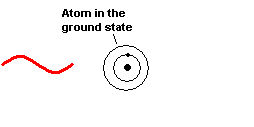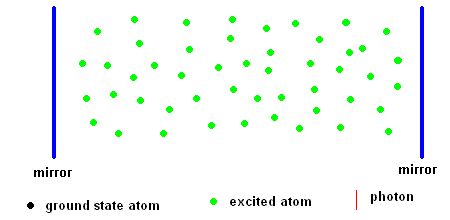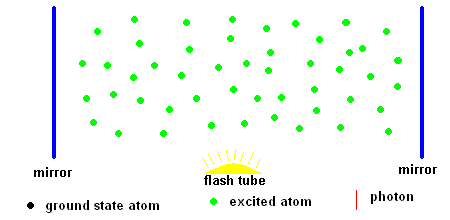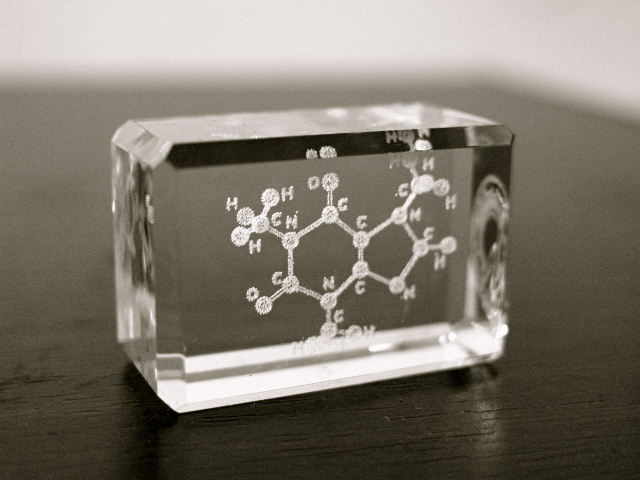Key Terms
constructive interference
coherent light
destructive interference
laser
superposition of waves
The word LASER is an acronym for Light Amplification by the Stimulated Emission of Radiation. Lasers have become very commonplace in our lives and are often used in devices and applications you may not even be aware of. It is hard to believe that so much has been done with a technology that has only been around since 1954. In that year, the first laser (actually called a maser) amplified microwaves. Soon afterwards, scientists found ways to amplify visible light. What is light amplification? You inherently know (from observing laser pointers) that laser light is very intense. Laser pointers come with a warning NOT to shine the light in people's eyes. The first step to understanding lasers lies in the principle of wave superposition.
Anyone who has been out on a lake in a canoe surrounded by power boats understands the principle of wave superposition. As multiple waves approach from different angles, oftentimes they seem to cancel each other out and the canoe is steady. The next instant the canoe can be rocked wildly about as two incoming waves join forces. Waves on water, sound waves, and electromagnetic radiation all exhibit what scientists call "constructive interference" and "destructive interference".
Consider a situation where two waves are moving through the same space at the same time. If the two waves move "out of phase" with each other, they work against each other and can literally cancel each other out. That is, if the crest of one wave rides with the trough of the other, you end up with nothing as they "destructively interfere". However, if the two waves both move "in phase" with each other, they work together to amplify the intensity of the light as they "constructively interfere". This makes the light very intense and is called coherent light. The trick is finding a way to make this happen with all the photons in a light beam. This special kind of amplified light comes from a laser. You now have the "Light Amplification" part done.
From our discussion on vapor lamps, you realize that once an electron is in the "excited state" (higher orbit), it will spontaneously drop back down to a lower level and emit a photon. Lasers work because there are ways to play "tricks" on atoms when the electrons are in the excited states. Physicists have found ways of exciting electrons (in certain atoms) to a higher energy state which stays there for an extended period of time. That is, they do not instantly move down to the ground state. This was mentioned when we spoke of phosphorescence (glowing in the dark). When most of the atoms in a sample have electrons held in this excited state, it is known as a "population inversion" by scientists. However, the electrons in these excited atoms can be "forced" to the ground state when they encounter a photon of light of a discrete wavelength (one color). As the photon pass by this "excited atom," it compels that atom to release an identical photon which is "in phase" with the original incoming photon. That is, the atom emits the same kind of radiation in the same direction and "in phase" with the original light. This is coherent light. Hopefully, you understand the Stimulated Emission of Radiation part.

Making
coherent light (animation)
In order to produce the intense beam of a laser, you need to get millions of atoms to cooperate. Step one is to "excite" a few atoms in the group. A nearby light source sends out photons through the gas. On occasion, an atom absorbs a passing photon which sends an electron of that atom into a higher orbit (you now have an excited atom). Now imagine the process depicted in the animation above occurring among millions of atoms in three-dimensional space. Not just atoms, but photons as well (of just one wavelength), all interacting. An atom absorbs a drifting photon and transfers an electron to a higher orbit. Along comes another photon (from any direction) and ... "pop" ... out go 2 photons (in the same direction). Those 2 "in sync" photons now move past another excited atom and ... "pop" ... you now have 3 photons moving together in the same direction. This process can snowball, until the train of photons hit the wall of the container and are absorbed. A dead end! To make matters worse, this is happening multiple times at any instant throughout the gas.
Consider the animation below where a large number of atoms are in the excited state. How did they get excited? A nearby light source called a flash tube (not shown) is spraying photons at the gas. Some photons are captured by the atoms in the cavity and become excited in the process. Watch what happens as some of these atoms spontaneously release a photon:

You will get Stimulated Emission of Radiation here, but without order (animation).
The animation shows that coherent light is produced, but it moves off in random directions and eventually becomes absorbed by the cavity wall.
To avoid this scenario, 2 parallel mirrors are placed at opposite sides of the chamber. This changes everything because any photons that are moving horizontally will hit the mirror, reflect back into the gas, and keep the party going (in a preferred direction). Watch the difference in the animation below:

Notice which photons survive (animation).
The next step is to keep the flash tube on, so new atoms can continually be excited.

Now keep adding energy with a flash tube (animation).
The last step is to make one of the mirrors semitransparent, meaning it will allow a small percent of photons to pass through (and will reflect the rest). This becomes the exit hole for your laser. Stated another way, only photons moving horizontally can escape the cavity through the semitransparent mirror. In the process, they form coherent light as they pass by other excited atoms and pick up a traveling companion.
Click link 6.1.a to watch a pretty good overview or link 6.1.b to learn about lasers for more information.
There are many types of lasers, each one carefully engineered to serve a specific purpose. The first laser produced red light and was known as a ruby laser. Ruby is an aluminum oxide crystal which is doped with small amounts of chromium atoms. Chromium atoms emit only red light in the visible portion of the spectrum when the excited atoms revert to the ground state. Other "red light" lasers are the Helium-Neon gas laser (used in UPC scanners) and diode lasers (used in laser pointers). Various types of lasers can produce other colors such as the Krypton (Kr) and mixed gas lasers (white light lasers) , solid state Nd:YAG lasers (green beams), and copper vapor lasers produce green and gold beams. If interested, click link 6.1.c for a list of the various types of lasers. The type of laser used for an application depends on the type of wavelength required, the duration of the pulse needed, the power required to operate them, as well as the output power required.
Light from a laser is monochromatic, meaning all one color (wavelength). The light is coherent, meaning all the photons march in unison, making it very intense. Finally, the beam is very narrow; it does not spread out like you see in a flashlight. Light with these properties can be very useful.
When America landed on the moon, the astronauts left small reflectors on the surface which would reflect any light back to its source. Since laser beams remain narrow over long distances, it became the perfect tool for this application. Since light travels at a known rate of 186,282.397 miles per second, all one needs to do is send a laser pulse to the moon and measure how much time it takes for the reflected wave to return (and divide by 2 for the one way trip). Since distance = rate * time, the distance to the moon is easily calculated. This is not only helpful to astronomers, but to anyone who needs to know the precise location of an object. Instrumentation is now so accurate you can use this same idea to measure how far away a wall is from the instrument. Laser distance measuring tools are now routinely available. Even minute motions such as crust motion due to plate tectonics are routinely monitored by laser distancing.
You can take this idea to several extremes. How about the "laser ear" which monitors the vibrations of certain glass windows? The human voice produces small compressions and rarefactions in the air which are then transmitted through space. For example, if you hold a balloon in your hand and hum, you can feel the vibrations produced in the balloon by your voice. Now imagine these voice waves doing the same thing to nearby windows. A laser can monitor these small vibrations and convert them into voice patterns ... careful what you say!
You can even get a ticket for speeding with this technique. The officer fires a laser pulse at your car and the instrument obtains a precise distance. A short time later, a second pulse obtains a new distance. Speed = change in distance ÷ time between successive pulses
Note: Echolocation will work with any type of wave or radiation (not just lasers). For example, bats use ultrasound to navigate a dark cave during flight to avoid hitting a stalagmite or stalactite.
Old timers, like me, still rely on traditional tools to get the job done. However, I put aside my "bubble" level and was forced to upgrade to a laser level when I saw how handy it was for working over long distances. Contractors now routinely use lasers for construction layout needs. Rotary laser levels are set up at construction sites and are able to project a self adjusting level beam in 360 degrees as a laser beam shines on a spinning mirror. Pipe lasers ensure that water has the proper drainage angles, and (as mentioned before) lasers can be used to measure distance (I still trust my tape measure, however).
Laser Level Photo by Bill Bradley via Wikimedia Commons
Laser beam welding (LBW) is another use of the laser. It uses a beam of light to provide the heat. An interesting fact about laser welding is that it can weld through transparent materials without harming the material between the laser and the weld joint.
Click link 6.1.d to see a laser welder at work (also laser cutting).
3-D printers are a way to make plastic copies of just about any object. Although there are several different ways to accomplish this, one technique uses an ultraviolet laser to harden a thin layer of liquid plastic (or plastic powder) which is deposited using an inkjet type nozzle. In this way, the target object is made one thin layer at a time in much the same way a stalagmite is formed in a cave. 3-D printers represent a new strategy in manufacturing known as Additive Manufacturing. In the past, if you wanted to make something, you either molded the item or used a stock piece and remove material until it took the desired shape (ask anyone in the tool and die industry). Using this additive technique, Michelangelo would have created his famous statue of David not from a huge block of marble, but by gluing tiny grains of sand together.
Click link 6.1.e to learn more.
Lasers are the key to engraving 3-D images into glass crystals. Lasers are programmed to concentrate beams to one precise microscopic location within the glass where it "burns" a tiny dot. This process is repeated millions of times to produce the desired image. You can even have customized images etched in glass. If interested, see a video at link 6.1.f

Images frozen in glass Courtesy Wikimedia Commons
Holograms are made by using lasers and the principle of wave superposition to create three-dimensional images.
To make a hologram, some three-dimensional object (chess piece) is illuminated by a laser. In addition, the beam is split, and an additional ray (called a reference beam) is projected to a mirror. Light is then reflected off the object and also reflected off the mirror where individual photons meet at the film. In the diagram, we consider what happens to two individual beams - one that hits the top section of the chess piece (shown in blue) and the corresponding ray directed along the reference beam. When the two rays meet at the film, they can arrive "in phase" (constructive interference) in which case the spot is bright. However, if they arrive completely "out of phase" (destructive interference) they produce no light at all. Light intensities can vary anywhere in between these two extremes as well. At the same time, millions of waves are arriving at the film from points reflected off other parts of the chess piece (and reference beam). This results in a very complex pattern of light and dark points on the film.
To view the hologram, you use a background laser which is oriented with the same angle as the reference beam. When the laser light hits the film, the light and dark patterns act like a diffraction grating and bend the light beam to your eyes. The pattern of the diffracted beam matches the rays reflected off the original chess piece. Therefore, a three-dimensional ghost virtual image of the chess piece appears in thin air. What makes this look 3D is each eye receives rays from a different direction ... just as it would if the actual chess piece were there.
Laser shows have entertained us during rock concerts, in Las Vegas, Studio 54 discos, and in many museums. A thin mist in the air acts to absorb a small amount of light and makes the beam appear like a wire stretching in space. The ability to use lenses and mirrors to quickly redirect the beam can be very impressive. Beam effects are done through the air (where the beam moves or changes intensity), or on screens where magnificent images can be drawn.
Powerful CO2 lasers are used in industry to cut steel and diamonds. These lasers produce their output in the far infrared or microwave region of the electromagnetic spectrum. This output is translated to searing heat.
Some surgeons are putting away the scalpel and picking up a laser. The intense light of a laser heats up the water within the cells and vaporizes it ... destroying the cell in the process.
Lasers can be used to drill holes, both big and small. The narrow beam of a laser allows micro-holes to be drilled in metals as well as much larger holes for deep gas wells (link 6.1.g). The heat of the laser has demonstrated it can be used to blast through bedrock in a technique called laser drilling.
Lasers are being used in many industries for cutting glass, wood, and plastics. Perhaps your eyeglasses were cut by a laser. Clothing manufacturers use lasers to cut through hundreds of layers of cloth at one time to cut garment patterns. Want to buy a laser cutter? Click link 6.1.h.
Perhaps you have already had your eyes corrected by LASIK surgery. LASIK stands for Laser-Assisted In Situ Keratomileusis. This procedure improves your vision by changing the shape of the cornea. This is accomplished as laser pulses vaporize portions of the cornea, the clear covering on the front of the eye.
How lasers remove tattoos is interesting. Lasers shoot short pulses of intense light that pass safely through the top layer of your skin. The tattoo pigment absorbs the laser light. The laser energy causes the tattoo pigment to break up in small fragments.
As mentioned above, surgeons use lasers for cutting. The advantage is that the heat of the laser instantly cauterizes any severed blood vessels and provides a sterile environment. Since the beam is so narrow, the damage to adjacent healthy tissue is minimized. Surgeons also use lasers for destroying tumors and drilling through bone tissue.
Lasers can be useful in healing tissue. Lasers are used to bond detached retinas to their surrounding cells. In some cases, wounds can be laser sealed without using bandages or stitches.
Lasers can be used to remove unwanted hair. It is great for light skinned and dark haired women. This advancement in laser for hair removal doesn't leave scarring or red spots. Want to put the hair back on? As of February 14, 2007 the US Food & Drug Administration (FDA) granted clearance for use of the HairMax LaserComb. This comb uses low level "cool lasers" to help grow new, thicker hair.
Laser Lithotrypsy is a procedure where a laser is used to blast kidney stones. A thin fiber optical tube is inserted through the urinary tract, and when a stone is located, a laser beam is fed through the tube to vaporize it.
Laser angioplasty uses a laser to remove plaque from the artery to prevent blockage in the heart.
Just want to look good? Plastic surgeons use lasers for cosmetic procedures such as reducing wrinkles, removing blemishes, varicose veins, and acne scars.
Lasers have found their way into dentists' chairs. There are a variety of uses for lasers in the field of dentistry. Lasers can be used to whiten teeth, remove cavities, and correct gum disease.

Courtesy Wikimedia Commons
UPC (Universal Product Code) scanners are routinely used to identify your purchases at all stores. Your FedEx® package has a unique barcode. Barcodes consists of black and white bars of varying thickness. At the checkout, a laser beam is constantly scanning space much like the laser levels discussed above. When the beam encounters a UPC label, the light is reflected off the white portion of the code and absorbed by the dark area. A photo sensor (attached to the scanner) identifies the product by the patterns of returned light. The system even has a check system just in case there are scanning errors. The first part of the code identifies the manufacturer (as a number). The second part identifies the product (as a number). The last part has a value that represents the sum of all digits. If part of the code is misread, the last digit will not check and the item will require rescanning.
Your computer may have a laser mouse. In this case, a laser replaces the LED a traditional optical mouse uses to illuminate the surface.
All optical disks (CD's, DVD's and Blu-ray) use lasers as readers (and writers). A laser beam is directed on the surface of the disk to distinguish light and dark patches (lands or pits) etched on the surface which reflect (or not) back to a photo sensor. These markings are translated to the digital 0 or 1 a computer understands. The newer Blu-ray® has a much higher storage capacity since the blue laser beam has a much shorter wavelength so it can distinguish data which is more compressed.
©2001, 2004, 2007, 2009, 2016 by Jim Mihal - All rights reserved
No portion may be distributed without the expressed written permission of the author